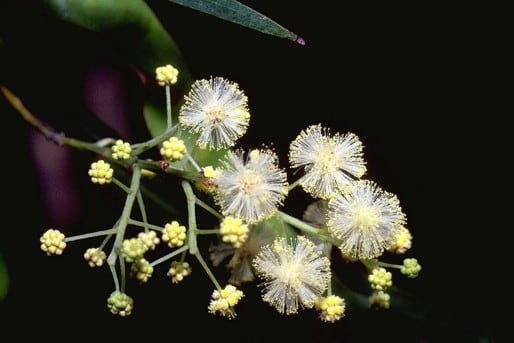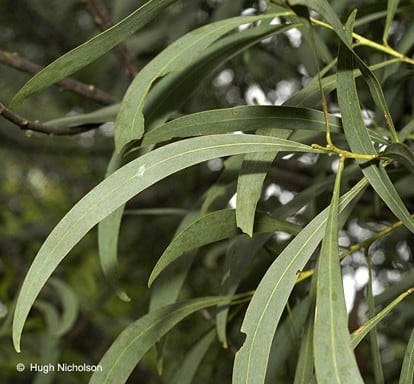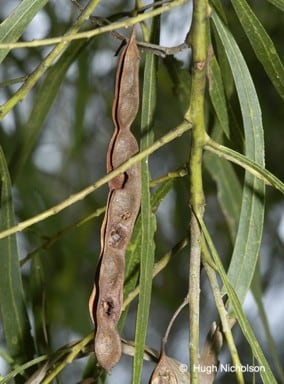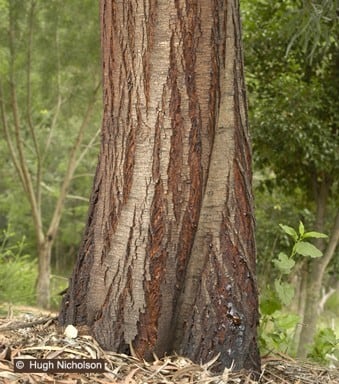Acacia mabellae Maiden
WATTLE
Acacias of Australia
Common Name
Mabel’s Wattle, Black Wattle
Family
Fabaceae
Distribution
Occurs in N.S.W. on the near-coastal slopes of the Great Divide from Higgins Ck, c. 40 km W of Camden, S to Bermagui; one collection from ‘near Bethungra’ is distributionally anomalous (i.e. H.Boyd, NSW178732).
Description
Shrub or tree 3–10 (-20) m high. New shoots golden (rarely white) puberulous. Branchlets angled at extremities, glabrous. Phyllodes somewhat pendulous, normally ±falcate, narrowly elliptic or sometimes oblanceolate, narrowed at both ends, (9–) 12–22 (–27) cm long, usually 7–15 mm wide, thin, glabrous, with prominent midrib, obscurely penninerved; gland 5–30 mm above pulvinus; margin shallowly indented at gland which is frequently connected to midrib by a fine oblique nerve. Inflorescences 6–16-headed racemes; raceme axes (1–) 1.5–5 (–8) cm long, often growing out, usually golden-puberulous; peduncles 5–12 mm long, slender, with indumentum as on raceme axes; heads globular, (12–) 17–20-flowered, creamy white. Flowers 5-merous; sepals united almost to their apices. Pods narrowly oblong, to 14 cm long, 9–11 (–15) mm wide, thinly coriaceous, glabrous. Seeds longitudinal to oblique, oblong to ovate-elliptic, 4–5 mm long; funicle encircling seed in a double fold, thick, black; aril clavate.
Habitat
Grows in sand in tall Eucalyptus forest, sometimes on the margin of rainforest.
Specimens
N.S.W.: Yerriyong, c. 13 km SW of Nowra, E.F.Constable 1268 (NSW); Central Tilba, 23 Oct. 1957, E.F.Constable s.n. (NSW, K); eastern side of Clyde Mtn, Budawang Ra., R.Pullen 3895 (NSW).
Notes
A member of the ‘A. microbotrya group’ with phyllodes often similar to those of A. falciformis, A. penninervis, A. retinodes, A. rubida or A. saliciformis. However, A. mabellae is distinguished by a combination of its usually yellow-hairy peduncles and raceme axes (hairs normally ±spreading), creamy white flower-heads, pods 9–11 mm wide and funicles encircling the seeds. The young raceme axes and peduncles are characteristically golden-puberulous with dense, ±spreading hairs. However, on mature racemes the hairs are often white to pale yellow, occasionally appressed and may become sparse with age (±glabrous in fruit). Acacia falciformis has a similar yellow indumentum except that the hairs are always closely appressed; it is further distinguished by heads 20–30-flowered, pods 15–25 mm wide and funicles not encircling seeds.
Specimens from Clyde R. and Mogo State Forest often have some phyllodes 20–25 mm wide.
The original spelling of the epithet is retained in preference to mabelliae, fide N.Hall & L.A.S.Johnson, The Names of Acacias of New South Wales 48 (1993).
FOA Reference
Data derived from Flora of Australia Volumes 11A (2001), 11B (2001) and 12 (1998), products of ABRS, ©Commonwealth of Australia
Author
Minor edits by B.R.Maslin & J.Rogers
B.R.Maslin
This identification key and fact sheets are available as a mobile application:
URL: https://apps.lucidcentral.org/wattle/
© Copyright 2018. All rights reserved.














